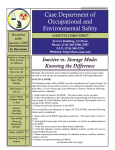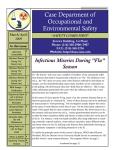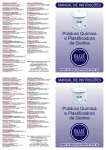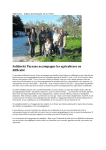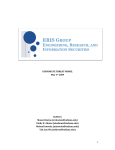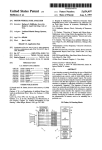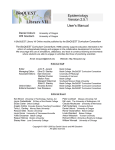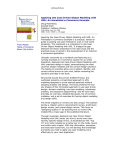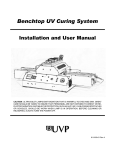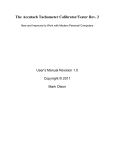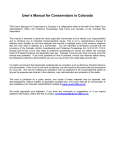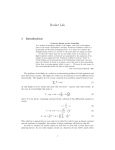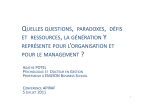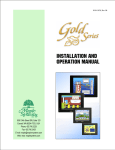Download Case Department of Occupational and Environmental Safety
Transcript
Case Department of Occupational and Environmental Safety April/May 2006 “ Safety Comes First ” Service Building, 1st Floor Phone: (216) 368-2906/2907 FAX: (216) 368-2236 Website: http://does.case.edu Inside this issue: Aging Workforce Will Require Adjustments to Workplace 2-3 Inactive Authorized User Status and Absence from the Lab; Irradiator 4 In an effort to establish in-person contact with researchers and lab personnel, DOES has a liaison program in place. Every 3 months, a DOES staff member will visit your area to document new concerns and follow up on previously registered concerns. All documentation is kept in a liaison file for future reference. Please take advantage of this service to answer any questions or address any concerns you might have regarding safety. DOES makes in-person visits to the following facilities (NOTE: this list is not all inclusive. Please contact DOES to inquire if your facility will receive a personal visit.) Frantic Over Finals? Some StressBusting Tips from 5-6 • BRB, Olin • Millis, DeGrace (Biology) • Med East, Wolstein • Rockefeller/Strosacker, Glennan • Hanna Pavilion, Bolwell, Sears Tower Spring Cleaning for Safety's Sake; Quiz: Know 7 • ARC, RBC/ Horwitz Tower • Cedar Service Center • Wearn, Pathology Upcoming Training Ses- 8 • AW Smith, Bingham • Dental, Nursing, Health Clinic • KHS, Sears Building Inspection Reports: Return Them Promptly 9 • White, University West • Research Tower, Wickenden • HG Wood, MacDonald Putting a Face on DOES: The DOES Liaison Program Page 2 Cas e D epart ment of Occu pati onal and En viron ment al S afety Aging Workforce Will Require Adjustments to Workplace Environment ASSE: Modify Workplace Safety for Older Labor Force DES PLAINES, IL, Nov. 3, 2005 — As the 'baby boomer' generation ages, the workforce is also shrinking, the American Society of Safety Engineers is urging business to modify their workplace safety efforts to accompany a changing workforce. Currently, workplace injury rates for older workers are the lowest of any age group, but their fatality rate is the highest. To accommodate the aging workforce and to work to reduce fatality rates, businesses should design a safe workplace for this aging, but valuable, workforce. “Businesses must act now to accommodate and provide a safer work environment for the aging worker, a valuable and experienced group, or their bottom line will be impacted negatively,” said ASSE President Jack H. Dobson, Jr., CSP. “There are easy and economical ways to do this that in the long run will save time, increase output and contribute positively to the business.” The U.S. Dept. of Labor's (DOL) workplace statistics for 2004 show that those 64 and older had the lowest number of workplace injuries, but the fatality rate for those 55 and older rose by 10 percent. In 2003, workers 65 and older "continued to record the highest fatality rate of any other age group, more than three times the rate of fatalities for those aged 25-34," according to the DOL. Most of these fatalities were transportation-related, from falls, from being struck by an object and from homicides. As baby boomers begin to retire over the next few years, the DOL notes the workforce will shrink as those born from 1965 to 1985, a time with a declining birthrate, enter the workforce. According to American Demographics magazine, currently there are 76.9 million baby boomers in the U.S. The majority of boomers live in California, Florida, Illinois, Michigan, New Jersey, New York, Ohio, Pennsylvania and Texas. “As the percentage of the workforce aged 55 and over increases, injury rates for the whole work population decreases while productivity increases,” said ASSE member Dr. Joel M. Haight, P.E., CSP, researcher and faculty member at Penn State University. An estimated 3.9 million occupational injuries and illnesses were treated in hospital emergency departments among all industry and occupation groups for workers aged 15 and older. The highest numbers of these injuries and illnesses occurred among workers aged 25-44. “Data suggests there is no age-related safety performance issue between the 25-54 year age group and that of the over 55 years age group, according to 2001-02 statistics,” writes ASSE member and Colorado resident Alma Jackson, R.N., MS, COHN-S in a paper titled "Health and Safety in an Aging Workforce." “Older workers are not more prone to injury and illness than other workers. Older workers have fewer avoidable absences, a lower turnover rate, and fewer work-related accidents. To increase workplace safety, employer fixes – environmental changes – can cost next to nothing yet the return on investment is very high,” said Jackson. The Society for Human Resource Management's (SHRM) 2004-05 workplace forecast identified the following trends: 1) the aging workforce; Cas e D epart ment of Occu pati onal and En viron ment al S afety Page 3 Aging Workforce Will Require Adjustments to Workplace Environment (Continued from Page 2) eldercare; 3) having both childcare and eldercare responsibilities; 4) changing family patterns; and 5) an increase in the unskilled workforce. “Management needs to be prepared to accommodate the number of changes older workers may face such as physical, sensory and perhaps some mental impediments,” said ASSE member Bruce Tulgan, Founder and President of RainmakerThinking Inc., a New Haven, CT-based workplace research firm. “As we age, we get shorter and heavier; our muscle strength decreases and by age 65, the mean maximum aerobic power – the level at which oxygen uptake levels off – is about 70 percent of what it was at age 25. Hearing and vision is also diminished as one ages.” Most experts agree that despite the aging process and its risks, older workers are not likely to take it easy on the job. “Even though older workers face additional obstacles to performing their job, they bring experience and knowledge and an excellent work ethic to the job making them a valuable part of the work force,” Tulgan said. “Equipment, facilities, and work processes can be improved to account for the limitations of the aging workforce and to take advantage of their experience and capabilities.” Knowing that there is no one-size-fits-all solution, the following are suggestions from ASSE members that can increase workplace safety for an aging workforce: • Improve illumination, add color contrast. • Eliminate heavy lifts, elevated work from ladders and long reaches. • Design work floors and platforms with smooth and solid decking while still allowing some cushioning. • Reduce static standing time. • Remove clutter from control panels and computer screens and use large video displays. • Reduce noise levels. • Install chain actuators for valve hand wheels, damper levers or other similar control devices – this brings the control manipulation to ground level – helps reduce falls. • Install skid resistant material for flooring and especially for stair treads – helps reduce falls. • Install shallow-angle stairways in place of ladders when space permits and where any daily elevated access is needed to complete a task – helps reduce falls. • Utilize hands free volume adjustable telephone equipment. • Increase task rotation which will reduce the strain of repetitive motion. • Lower sound system pitches, such as on alarm systems, as they tend to be easier to hear. (Continued on page 9) Page 4 Cas e D epart ment of Occu pati onal and En viron ment al S afety Inactive Authorized User Status and Absence from the Lab The Radiation Safety Office (RSOF) at DOES has an Authorized User (AU) classification of “inactive AU” for laboratories that do not need to possess or use radioactive material in the foreseeable future. An inactive AU is relieved of the requirements to send in biannual inventories, complete laboratory contamination surveys, and adhere to the annual retraining policy. “To become inactive, the AU must send a letter either by fax or email to Karen Janiga, Assistant RSO ([email protected] or Fax: 216368-2236).” To become inactive, the AU must send a letter either by fax or e-mail to Karen Janiga, Assistant RSO ([email protected] or Fax: 216-368-2236). All AUs must follow the guidelines as stated in the Laboratory Decommissioning/Lab Relocation section of the Radiation Safety Lab User Manual (page 26 of the current manual or access the manual online at http://www.case.edu/finadmin/does/web/ RadSafety/Radsafety.htm). Moreover, if the AU wishes to become active again, a letter must be sent by either fax or e-mail to Karen, requesting reactivation. Also, it is important to send updated room maps and an updated protocol to the Assistant RSO. Please verify that training is current, that survey meters are calibrated, and that personnel receive the required personal dosimetry. If you are going to be absent from your lab for greater than five working days or are going on a sabbatical, another AU in the same department (not a technician) must be designated to assume responsibility for all radiation safety issues. Please contact Karen Janiga indicating the date you are leaving, when you will be returning, and providing the name of the AU that will be assuming responsibility for all radiation safety issues in your absence. Irradiator Program Since all irradiators on the CASE campus are included in our ODH license, the RSOF has developed an irradiator program. This program is scheduled to go online January 1, 2006. A separate irradiator manual has been written and will be available on our website by the end of January 2006. All irradiators will be audited by the RSOF 3 times per year. This audit will include a leak test of the irradiator, area surveys, area monitor calibration, worker training, and an inspection of the irradiator user logbook. Individuals using the irradiator will be required to attend New Radiation Laboratory Worker Training class, and will be required to retrain annually. Moreover, current Lab Safety training is also necessary to participate in the Irradiator Program. A site-specific training class must also be completed prior to using the irradiator. Documentation of this training is sent to the RSOF. Currently, there is no annual retraining requirement for site-specific training. Additional security measures required by the ODH regarding irradiators are currently being developed and will be communicated via e-mail to all irradiator users. Cas e D epart ment of Occu pati onal and En viron ment al S afety Page 5 Frantic Over Finals? Some Stress-Busting Tips Final exam stress can rear its ugly head even for the most prepared student. Unfortunately, final exam season comes equipped with all kinds of additional headaches, from all-nighters and highlighters to study sessions and final deadlines. If your first finals week is approaching at Case or, if you’ve been known to reach for the caffeine, Advil, Krispy Kremes, or Immodium AD as part of your final exam week study ritual in the past, here are some hints to help you cope and stay healthy during finals week. First and foremost, try not to leave things until the last minute and develop a realistic time table for hitting the books. This will help you avoid a lot of the last minute cramming and as a result of being well-prepared, you’ll go into exam week feeling more confident. Balance out your study schedule: leave time for fun and relaxation during finals week to avoid burning out. When you start to feel tired and hazy while you are studying allow yourself to take a short break. You’ll be more relaxed and refreshed when you return to your work. Rather than reaching for a cup of coffee or a fizzy soda to perk you up, try some moderate and regular exercise. Working out can boost your energy levels throughout the day and will also help to clear your mind as well as reduce stress and anxiety. Make sure to eat well and sleep well. It is important to both feed your brain and rest it. Try to get at least 6 hours of sleep a night. Here are some other helpful and healthy hints to keep in mind as you study for finals or for any other exams throughout the year: Believe in yourself: You’ve made it this far because you belong here at Case and in each one of your classes. There is no reason to worry excessively. Prepare for your exams and you will do fine. You do NOT have to be perfect: Aim to do your best, but no one can be perfect all of the time. Believing that anything less than an A means that you have failed just puts added pressure and unnecessary stress on yourself during an already stressful time. “Rather than reaching for a cup of coffee or a fizzy soda to perk you up, try some moderate and regular exercise. Working out can boost your energy levels throughout the day and will also help to clear your mind as well as reduce stress and anxiety. ” Keep everything in perspective: Even though exams seem like the most important thing while you are in the midst of taking them, remember that they are only a small part of the big picture. Do not keep things bottled up: If you are feeling particularly stressed, confiding in someone close to you can make you feel so much better. Turn to the people who are most supportive of you. (continued on page 6) Page 6 Cas e D epart ment of Occu pati onal and En viron ment al S afety Frantic Over Finals? Some Stress-Busting Tips from D.O.E.S. “If you are truly frantic over finals and overwhelmed, there are places to turn to. University Counseling Services (Sears 201) can be reached at 3685872. A counselor is on call 24 hours a day, 7 days a week. Call 8448892 and ask for the University counselor.” Ask for help if you need it: If you are having trouble with any of your course material, worrying about it will not help. Lean on your classmates or a tutor. When it comes to taking the exam, there are several things that you can do to handle the stress of exam taking. Plan to arrive at the classroom early and make sure to bring all of the necessary items with you (calculators, sharpened pencils, blue books, etc.). Take a deep breath before you begin your exam and read the instructions and questions carefully. Make a plan for taking the exam and be sure to leave enough time to tackle each question, problem, or essay. Begin with the questions you are most confident about answering. Avoid panic. Close your eyes and take some deep breaths to calm yourself if you feel overly nervous for a quick and easy way to alleviate stress. This will help you stay clearly focused on your exam. If you have to, give yourself a bit of a pep talk. Slowing down your breathing often helps if your mind goes blank on a question. If, after a minute, you still have trouble recalling the information, move on to another question and return to the troubling question later. After an exam, give yourself some time to relax and congratulate yourself on completing a difficult task. Try not to be over-critical. We are our own worst critics and can often be far too harsh on ourselves. Rather than criticizing yourself if you think you could have done better, try to learn from your mistakes and if you feel anxious after your exam, make sure to talk with someone. Do not overcelebrate after an early exam so that you do not tire yourself out, and be considerate; others may be studying even if your finals are over. If you are truly frantic over finals and overwhelmed, there are places to turn to. University Counseling Services (Sears 201) can be reached at 368-5872. A counselor is on call 24 hours a day, 7 days a week. Call 844-8892 and ask for the University counselor. Date Reminders for Graduates • • • May 1 Last Day of Classes May 2-3 Reading Days May 4-11 Final Exam Days Cas e D epart ment of Occu pati onal and En viron ment al S afety Page 7 Spring Cleaning for Safety's Sake The end of the school year is a good time to put your laboratory in order, especially since the students have left and the lab is less chaotic. If this hasn’t already been done, take care of these few “housekeeping” tasks that will put your lab into good shape for summer. 1) Clean out chemical stocks. Go through your laboratory shelves and properly dispose of any chemicals that are no longer used or needed. We strongly recommend that this kind of sorting be done often for many reasons: • it keeps disposal costs down since there are smaller amounts to dispose of; • it reduces the possibility of these chemicals becoming potentially-dangerous “unknowns," which can happen if labels fall off or get defaced; • it reduces hazards in the lab -- the fewer chemicals around the better, especially if the identities of some of the compounds are uncertain. A new chemical inventory should be submitted to DOES after disposal of any chemicals. If some of the chemicals are transferred to a co-worker's lab, that person must also submit an updated inventory list reflecting the changes. 2) Dispose of trash promptly — especially hazardous and radioactive waste. Call DOES (x2906) to arrange disposal (with the appropriate accompanying paperwork completed) as early as possible in the day so we can process the request. 3) Go over training materials so that they reflect any changes to the laboratory’s safety procedures and protocols. New students beginning work in the summer (and especially next fall) will then have the most up-to-date set of materials and guidelines to follow. Happy cleaning! Quiz: Know Your Role Here are a few questions EVERY lab worker should be able to answer: 1. Who is your P.I.? 2. Where is your CHP? 3. To what chemicals/radiation are you exposed to? 4. Where can MSDS be obtained for these chemicals? 5. What are the hazards associated with these chemicals/this radiation? 6. How do you protect yourself from these hazards? Take 5-10 minutes this week to do this exercise in your lab so that EVERYONE knows the answer to these very important questions. Page 8 Cas e D epart ment of Occu pati onal and En viron ment al S afety Upcoming Training Sessions* *As always, consult our website (http://does.case.edu) for a full schedule of training sessions New Radiation Safety Training Retraining is required annually. DOES conference room - Service Building 1st Floor PREREGISTRATION IS REQUIRED ! - Please call 368-2906 X-Ray Safety Training DOES conference room - Service Building 1st Floor PREREGISTRATION IS REQUIRED ! - Please call 368-4601 or email [email protected] Laser Safety Training DOES conference room - Service Building 1st Floor PREREGISTRATION IS REQUIRED ! - Please call 368-4600 or email [email protected] The Laser Safety training schedule is now available online at the DOES website <does.case.edu> under Laser Training. Listed below are the training dates through June 2006: Wednesday, May 3, 1:00 PM Friday, June 2, 10:00 AM Bloodborne Pathogen Training DOES conference room - Service Building 1st Floor PREREGISTRATION IS REQUIRED ! - Please call 368-2907 Initial training must be completed in person. For renewal training, there is an online version of this class. You do not have to attend the class if you are renewing your training. Held every Tuesday afternoon from 3:00 to 4:30 p.m. Additional training classes schedule: Formaldehyde, Benzene, Methylene Chloride, and Vinyl Chloride Retraining Please call 368-2907 to preregister for this class. There are online versions of Formaldehyde and Benzene retraining. If you take the online versions of Benzene or Formaldehyde you do not have to take the class. Class Objective: Chemical specific training (continued on page 10) Cas e D epart ment of Occu pati onal and En viron ment al S afety Page 9 Inspection Reports: Return Them Promptly It is important to think of Laboratory Inspection Reports as a reciprocal process. Once you receive an inspection report, you must comply promptly with the violation, sign and date the report, and then return the report to DOES. Once the report is returned, there is a complete record of the incident for future reference. If you are in need of a duplicate form, please contact Felice Thorton-Porter ([email protected] or ext. 5865). She will forward a copy to you via email or fax. Thank you for your prompt compliance in this matter. Aging Workforce Will Require Adjustments to Workplace Environment (Continued from Page • Lengthen time requirements between steps in a task. • Increase the time allowed for making decisions. • Consider necessary reaction time when assigning older workers to tasks. • Provide opportunities for practice and time to develop task familiarity. Implementing these changes would not only help older workers, but would benefit all workers. ASSE resources on this issue include ASSE's Professional Safety Journal December 2003 article titled ‘Human Error & the Challenges of an Aging Workforce' by Dr. Haight, his ASSE 2005 Professional Development Conference (PDC) presentation titled ‘Designing for an Aging Workforce' and ASSE member Alma Jackson's PDC presentation titled ‘Effective Safety Training for an Aging Workforce'. © American Society of Safety Engineers News Humor Corner OSHA Laboratory Safety and Regulated Chemical Training DOES conference room—Service Building 1st Floor PREREGISTRATION IS REQUIRED ! - Please call 368-2907 Held every Tuesday afternoon from 1:00 to 3:00 pm Hazard Communication Training (Right-to-Know) Crawford, Room 209 DOES STAFF W. David Sedwick, Ph.D., (wds), Director and RSO Felice Thornton-Porter (fst2), Q.A. Specialist II Shirley Mele (smm5), Dept. Administrator II Gwendolyn Cox-Johnson (gxc13), Dept. Assistant II Virginia LaGuardia (vfl), Dept. Assistant II Ronald Tulley (rxt33), Technical Writer Patricia Pitingolo (pap17), Dept. Assistant I Held every Tuesday afternoon from 1:00 to 2:30 pm Chemical Safety Additional training classes schedule (Note: additional classes will be held in the DOES conference room located in the Safety Service Building): Marc Rubin (mdr6), Assistant Director, EH&S Robert Latsch (rnl2), Specialist I Bill Cummins (whc7), Plant Safety Specialist II Arif Peshimam (azp1), Specialist II Radiation Safety Retraining Please retrain on the Internet @: http://does.case.edu Annual Respirator Training DOES conference room—Service Building 1st Floor. Romulo Deza (rbd8), Specialist I Bill DePetro (wjd11), Specialist II Tom Merk (tlm8), Specialist I Paul Holter (pah9), Specialist I PREREGISTRATION IS REQUIRED ! - Please call 368-2907 Radiation Safety There is an online version of this class. If you take the online version you do not have to take the class. But you still need to come in for a fit test. Edward Traverso, RRPT (ejt), Radiation Operations Supervisor, Specialist II Karen Janiga (kej2), Assistant RSO Yelena Neyman (yxt13), Specialist I Joanna Bielawski (jxb153), Specialist I Henry Wayne Justice (hwj), Specialist I Cheng Zhou (cxz16), Analyst Programmer II Jennifer Ress (jtr10), Specialist I Department of Occupational and Environmental Safety University (216) 368-2906/2907 Case Western Reserve FAX: (216) 368-2236










